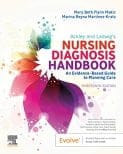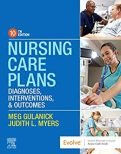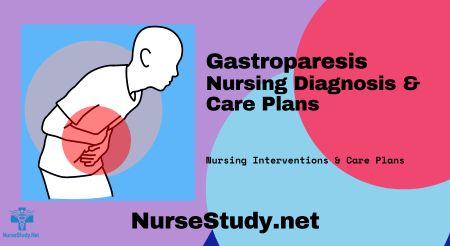Definition
Nursing Diagnosis Definition for Gastroparesis: Impaired Gastric Emptying related to delayed gastric motility as evidenced by nausea, vomiting, early satiety, abdominal distention, and bloating.
Defining Characteristics of Gastroparesis:
Subjective:
- Nausea
- Vomiting
- Early satiety (feeling full after eating small amounts)
- Abdominal discomfort or pain
- Bloating and distention
Objective:
- Absent or decreased bowel sounds
- Palpable abdominal mass
- Evidence of malnutrition or weight loss
- Dehydration
- Electrolyte imbalances
Related Factors:
- Diabetes mellitus
- Post-surgical complications
- Medication side effects (e.g., opioids, anticholinergics)
- Neurological disorders (e.g., Parkinson’s disease, multiple sclerosis)
- Autoimmune disorders (e.g., scleroderma)
Risk Population:
- Individuals with diabetes mellitus
- Individuals with a history of gastrointestinal surgery
- Individuals with neurological or autoimmune disorders
Associated Problems:
- Malnutrition
- Dehydration
- Electrolyte imbalances
- Decreased quality of life
- Impaired glucose control (in individuals with diabetes)
Suggestions for Use:
- Assess for subjective and objective symptoms of gastroparesis.
- Review the patient’s medical history, medication list, and recent surgical procedures.
- Identify any underlying conditions that contribute to gastroparesis.
- Collaborate with the healthcare team to develop an individualized care plan.
- Educate the patient about dietary modifications and medication management.
Suggested Alternative NANDA Diagnoses:
- Imbalanced Nutrition: Less Than Body Requirements
- Risk for Imbalanced Fluid Volume
- Chronic Pain
- Impaired Skin Integrity
- Ineffective Coping
Usage Tips:
- Monitor the patient’s symptoms regularly.
- Keep track of the patient’s fluid and nutritional intake.
- Encourage the patient to maintain a balanced diet and adhere to prescribed medications.
- Provide emotional support and education to the patient and their family.
- Collaborate with other healthcare professionals to optimize the patient’s care.
NOC Outcomes:
- Nutritional Status: Food and Fluid Intake
- Fluid Balance
- Pain Level
- Skin Integrity
- Coping
NOC Results:
- Patient demonstrates improved nutritional intake.
- Patient maintains adequate fluid balance.
- Patient reports decreased pain levels.
- Patient maintains intact skin.
- Patient demonstrates effective coping strategies.
NIC Interventions:
- Monitor and manage symptoms of gastroparesis, such as nausea and vomiting.
- Assess and maintain fluid and electrolyte balance.
- Provide nutritional support and monitor the patient’s dietary intake.
- Administer medications as prescribed and monitor their effectiveness.
- Educate the patient and their family about self-care management strategies.
- Collaborate with the healthcare team to coordinate interdisciplinary care and referrals as needed.
Gastroparesis Nursing Care Plans
Imbalanced Fluid Volume Nursing Care Plan for Gastroparesis
Nursing Diagnosis: Imbalanced Fluid Volume related to fluid intake imbalance secondary to gastroparesis.
Related Factors/Causes:
- Delayed gastric emptying
- Nausea and vomiting
- Reduced oral intake due to early satiety
- Fluid losses through vomiting and diarrhea
- Inadequate fluid replacement
Desired Outcomes:
- Maintain fluid and electrolyte balance within normal parameters.
- Adequate hydration status as evidenced by stable vital signs, normal urine output, and moist mucous membranes.
- Absence of signs and symptoms of dehydration, such as dry skin, thirst, and orthostatic hypotension.
- No weight loss or evidence of malnutrition.
Nursing Interventions for Gastroparesis
- Assess and monitor the patient’s fluid status regularly, including vital signs, urine output, and skin turgor.
- Encourage oral fluid intake as tolerated, offering small, frequent sips of water or clear liquids.
- Collaborate with the healthcare team to develop an individualized fluid replacement plan based on the patient’s needs.
- Administer intravenous fluids as prescribed, ensuring proper rate and monitoring for any signs of fluid overload.
- Educate the patient and their family about the importance of adequate fluid intake and strategies to increase oral fluid intake.
- Monitor and manage any complications related to fluid and electrolyte imbalances, such as administering electrolyte replacements as prescribed.
Evaluation:
- The patient’s vital signs remain within normal limits.
- The patient demonstrates adequate urine output within expected parameters.
- The patient’s mucous membranes are moist, and there are no signs of dehydration.
- The patient maintains weight and shows no evidence of malnutrition.
- The patient verbalizes understanding of the importance of fluid intake and adherence to the prescribed fluid replacement plan.
Chronic Pain Nursing Care Plan for Gastroparesis
Nursing Diagnosis: Chronic Pain related to delayed gastric emptying and abdominal discomfort associated with gastroparesis.
Related Factors/Causes:
- Delayed gastric motility leading to prolonged stomach distention.
- Nerve damage or dysfunction in the gastrointestinal system.
- Inflammation or irritation of the stomach lining.
- Abdominal muscle tension and spasms.
- Psychological factors such as anxiety or depression.
Desired Outcomes:
- Manage and reduce chronic pain levels.
- Increase patient’s comfort and ability to perform activities of daily living.
- Promote improved quality of life by enhancing pain management strategies.
- Minimize the impact of pain on the patient’s emotional well-being.
Gastroparesis Nursing Interventions:
- Assess and document the location, intensity, and characteristics of the pain using appropriate pain assessment tools.
- Collaborate with the healthcare team to develop an individualized pain management plan, considering both pharmacological and non-pharmacological interventions.
- Administer pain medications as prescribed, ensuring adherence to the prescribed schedule.
- Apply heat or cold therapy to the abdomen as appropriate, based on patient preference and healthcare provider’s recommendations.
- Teach relaxation techniques, deep breathing exercises, and guided imagery to help the patient manage pain and reduce muscle tension.
- Encourage the patient to adopt a comfortable position and provide supportive pillows or positioning aids to alleviate discomfort.
- Educate the patient about the importance of adherence to the prescribed pain management regimen and potential side effects of medications.
- Assess and address any psychological factors contributing to pain, such as anxiety or depression, and involve appropriate healthcare professionals for further evaluation and intervention.
Evaluation:
- The patient reports a reduction in pain levels.
- The patient demonstrates increased comfort and improved ability to perform activities of daily living.
- The patient engages in effective pain management strategies.
- The patient’s emotional well-being is improved, with reduced impact of pain on their overall quality of life.
Note: The nursing care plan provided above focuses on the Chronic Pain nursing diagnosis for gastroparesis. It is important to collaborate with the healthcare team and tailor the care plan to the specific needs and condition of the individual patient. Additionally, regular reassessment and adjustment of interventions may be necessary to optimize pain management.
Nursing Test Practice Questions for Gastroparesis
Question 1: A patient with gastroparesis is at risk for which of the following complications?
A) Malnutrition
B) Hypertension
C) Hyperglycemia
D) Urinary incontinence
Answer: A) Malnutrition
Rationale: Gastroparesis, characterized by delayed gastric emptying, can lead to inadequate intake of nutrients and increased risk of malnutrition. The condition affects the normal digestion and absorption of food, resulting in reduced appetite, early satiety, and weight loss.
Question 2: The nurse is caring for a patient with gastroparesis who complains of severe nausea. Which intervention should the nurse prioritize?
A) Administering antiemetic medication as prescribed
B) Providing a high-fiber diet
C) Encouraging the patient to drink carbonated beverages
D) Instructing the patient to eat large meals at once
Answer: A) Administering antiemetic medication as prescribed
Rationale: Severe nausea is a common symptom of gastroparesis. Administering antiemetic medication as prescribed can help alleviate nausea and improve the patient’s comfort. It is important to follow the healthcare provider’s orders regarding antiemetic medication administration.
Question 3: A patient with gastroparesis is scheduled for surgery. What precaution should the nurse take when administering preoperative medications?
A) Withhold oral medications on the day of surgery
B) Administer medications with a full glass of water
C) Crush medications and mix with food
D) Use intravenous route for medication administration
Answer: D) Use intravenous route for medication administration
Rationale: Due to delayed gastric emptying in gastroparesis, oral medications may not be absorbed effectively. Therefore, it is advisable to use the intravenous route for medication administration before surgery to ensure optimal absorption and therapeutic effect.
Question 4: Which dietary modification is appropriate for a patient with gastroparesis?
A) Consuming high-fiber foods
B) Eating large, infrequent meals
C) Avoiding fatty and greasy foods
D) Drinking caffeinated beverages
Answer: C) Avoiding fatty and greasy foods
Rationale: Fatty and greasy foods can exacerbate symptoms of gastroparesis and delay gastric emptying further. Patients with gastroparesis should focus on consuming low-fat, easily digestible foods in smaller, more frequent meals to facilitate gastric emptying and reduce symptoms.
Question 5: The nurse is assessing a patient with gastroparesis and finds a distended abdomen with absent bowel sounds. What action should the nurse take?
A) Encourage the patient to walk around the unit
B) Administer a laxative to promote bowel movement
C) Assess for signs of bowel obstruction or perforation
D) Document the findings as normal for gastroparesis
Answer: C) Assess for signs of bowel obstruction or perforation
Rationale: A distended abdomen with absent bowel sounds can indicate complications such as bowel obstruction or perforation, which require immediate medical attention. The nurse should assess the patient further, notify the healthcare provider, and be prepared to implement appropriate interventions based on the assessment findings.
Nursing References
Ackley, B. J., Ladwig, G. B., Makic, M. B., Martinez-Kratz, M. R., & Zanotti, M. (2020). Nursing diagnoses handbook: An evidence-based guide to planning care. St. Louis, MO: Elsevier.
Gulanick, M., & Myers, J. L. (2022). Nursing care plans: Diagnoses, interventions, & outcomes. St. Louis, MO: Elsevier.
Ignatavicius, D. D., Workman, M. L., Rebar, C. R., & Heimgartner, N. M. (2020). Medical-surgical nursing: Concepts for interprofessional collaborative care. St. Louis, MO: Elsevier.
Silvestri, L. A. (2020). Saunders comprehensive review for the NCLEX-RN examination. St. Louis, MO: Elsevier.
Best Nursing Books and Resources
These are the nursing books and resources that we recommend.
NurseStudy.net is a participant in the Amazon Services LLC Associates Program. Included below are affiliate links from Amazon at no additional cost from you. We may earn a small commission from your purchase. Please see our Privacy Policy

The Nursing Diagnosis Handbook E-Book: An Evidence-Based Guide to Planning Care
This is an excellent reference for nurses and nursing students. While it is a great resource for writing nursing care plans and nursing diagnoses, it also helps guide the nurse to match the nursing diagnosis to the patient assessment and diagnosis.
This handbook has been updated with NANDA-I approved Nursing Diagnoses that incorporates NOC and NIC taxonomies and evidenced based nursing interventions and much more.

NANDA International Nursing Diagnoses: Definitions & Classification, 2021-2023
All introductory chapters in this updated version of a ground-breaking text have been completely rewritten to give nurses the knowledge they require to appreciate assessment, its relationship to diagnosis and clinical reasoning, and the goal and use of taxonomic organization at the bedside.

Nursing Care Plans: Nursing Diagnosis and Intervention
It contains more than 200 care plans that adhere to the newest evidence-based recommendations.
Additionally, it distinguishes between nursing and collaborative approaches and highlights QSEN competencies.
Disclaimer:
Please follow your facilities guidelines, policies, and procedures.
The medical information on this site is provided as an information resource only and is not to be used or relied on for any diagnostic or treatment purposes.
This information is intended to be nursing education and should not be used as a substitute for professional diagnosis and treatment.


